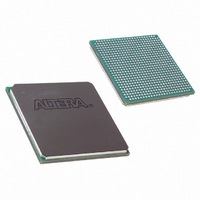EP1SGX10DF672C5N Altera, EP1SGX10DF672C5N Datasheet - Page 87

EP1SGX10DF672C5N
Manufacturer Part Number
EP1SGX10DF672C5N
Description
IC STRATIX GX FPGA 10KLE 672FBGA
Manufacturer
Altera
Series
Stratix® GXr
Datasheet
1.EP1SGX10CF672C7N.pdf
(272 pages)
Specifications of EP1SGX10DF672C5N
Number Of Logic Elements/cells
10570
Number Of Labs/clbs
1057
Total Ram Bits
920448
Number Of I /o
362
Voltage - Supply
1.425 V ~ 1.575 V
Mounting Type
Surface Mount
Operating Temperature
0°C ~ 85°C
Package / Case
672-FBGA
Lead Free Status / RoHS Status
Lead free / RoHS Compliant
Number Of Gates
-
Available stocks
Company
Part Number
Manufacturer
Quantity
Price
- Current page: 87 of 272
- Download datasheet (3Mb)
Altera Corporation
February 2005
or regional clock. In contrast, a circuit using asynchronous RAM must
generate the RAM WREN signal while ensuring its data and address
signals meet setup and hold time specifications relative to the WREN
signal. The output registers can be bypassed. Flow-through reading is
possible in the simple dual-port mode of M512 and M4K RAM blocks by
clocking the read enable and read address registers on the negative clock
edge and bypassing the output registers.
Two single-port memory blocks can be implemented in a single M4K
block as long as each of the two independent block sizes is equal to or less
than half of the M4K block size.
The Quartus II software automatically implements larger memory by
combining multiple TriMatrix memory blocks. For example, two
256 × 16-bit RAM blocks can be combined to form a 256 × 32-bit RAM
block. Memory performance does not degrade for memory blocks using
the maximum number of words available in one memory block. Logical
memory blocks using less than the maximum number of words use
physical blocks in parallel, eliminating any external control logic that
would increase delays. To create a larger high-speed memory block, the
Quartus II software automatically combines memory blocks with LE
control logic.
Parity Bit Support
The memory blocks support a parity bit for each byte. The parity bit,
along with internal LE logic, can implement parity checking for error
detection to ensure data integrity. You can also use parity-size data words
to store user-specified control bits. In the M4K and M-RAM blocks, byte
enables are also available for data input masking during write operations.
Shift Register Support
You can configure embedded memory blocks to implement shift registers
for DSP applications such as pseudo-random number generators, multi-
channel filtering, auto-correlation, and cross-correlation functions. These
and other DSP applications require local data storage, traditionally
implemented with standard flip-flops, which can quickly consume many
logic cells and routing resources for large shift registers. A more efficient
alternative is to use embedded memory as a shift register block, which
saves logic cell and routing resources and provides a more efficient
implementation with the dedicated circuitry.
The size of a w × m × n shift register is determined by the input data
width (w), the length of the taps (m), and the number of taps (n). The size
of a w × m × n shift register must be less than or equal to the maximum
number of memory bits in the respective block: 576 bits for the M512
Stratix GX Device Handbook, Volume 1
Stratix GX Architecture
4–21
Related parts for EP1SGX10DF672C5N
Image
Part Number
Description
Manufacturer
Datasheet
Request
R

Part Number:
Description:
CYCLONE II STARTER KIT EP2C20N
Manufacturer:
Altera
Datasheet:

Part Number:
Description:
CPLD, EP610 Family, ECMOS Process, 300 Gates, 16 Macro Cells, 16 Reg., 16 User I/Os, 5V Supply, 35 Speed Grade, 24DIP
Manufacturer:
Altera Corporation
Datasheet:

Part Number:
Description:
CPLD, EP610 Family, ECMOS Process, 300 Gates, 16 Macro Cells, 16 Reg., 16 User I/Os, 5V Supply, 15 Speed Grade, 24DIP
Manufacturer:
Altera Corporation
Datasheet:

Part Number:
Description:
Manufacturer:
Altera Corporation
Datasheet:

Part Number:
Description:
CPLD, EP610 Family, ECMOS Process, 300 Gates, 16 Macro Cells, 16 Reg., 16 User I/Os, 5V Supply, 30 Speed Grade, 24DIP
Manufacturer:
Altera Corporation
Datasheet:

Part Number:
Description:
High-performance, low-power erasable programmable logic devices with 8 macrocells, 10ns
Manufacturer:
Altera Corporation
Datasheet:

Part Number:
Description:
High-performance, low-power erasable programmable logic devices with 8 macrocells, 7ns
Manufacturer:
Altera Corporation
Datasheet:

Part Number:
Description:
Classic EPLD
Manufacturer:
Altera Corporation
Datasheet:

Part Number:
Description:
High-performance, low-power erasable programmable logic devices with 8 macrocells, 10ns
Manufacturer:
Altera Corporation
Datasheet:

Part Number:
Description:
Manufacturer:
Altera Corporation
Datasheet:

Part Number:
Description:
Manufacturer:
Altera Corporation
Datasheet:

Part Number:
Description:
Manufacturer:
Altera Corporation
Datasheet:

Part Number:
Description:
CPLD, EP610 Family, ECMOS Process, 300 Gates, 16 Macro Cells, 16 Reg., 16 User I/Os, 5V Supply, 25 Speed Grade, 24DIP
Manufacturer:
Altera Corporation
Datasheet:












